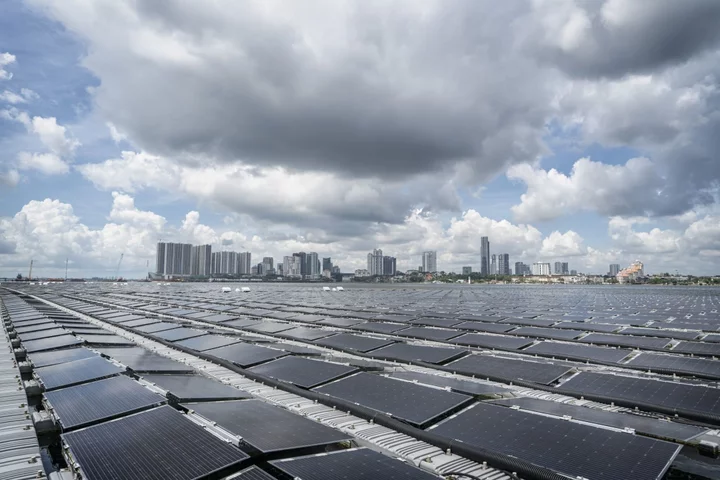(Bloomberg) --
Singapore has gone from a mudflat swamp with fishing villages to an island metropolis boasting one of the world’s highest incomes and population densities—in a little more than 150 years. It’s going to have to go through a different kind of transformation in less than 30 years, if it’s to meet its newly set goal of reaching net-zero emissions by 2050.
The formula to reach net-zero requires a country to move to carbon-free energy sources and capture any residual emissions that it cannot fully mitigate. But building renewables like solar and wind requires a lot of land, one thing Singapore doesn’t have. That’s why the country has floated the idea of importing renewable energy from other nations (even as far as Australia) through long undersea cables. But the high cost and technical hurdles behind such ideas means they have yet to fully come to fruition. The watchdog Climate Action Tracker currently rates the island country’s climate plan “critically insufficient.”
While Singapore’s gameplan has its critics, it’s made progress in several pockets that many small-island countries can learn from. Singapore has deployed and scaled up some of the technologies that will prove crucial for any island country’s survival in the 21st century. Last month, we got to tour a number of them.
District cooling
Five floors below the luxury shops at Marina Bay Sands, SP Group runs a giant cooler. It provides cooling to dozens of skyscrapers and developments in the vicinity, saving a huge amount of premium space in each building that would otherwise be taken by air conditioning equipment.
Crucially, the bigger a cooling network, the more energy efficient it can be. In one test, when SP Group connected an existing building with its own cooling system, its energy use dropped 40%, said Foo Yang Kwang, SP Group’s chief engineer of sustainable energy solutions.
Read More: Solving the Global Cooling Problem
The plant can also act like a huge ice battery. During off-peak hours, such as at night, the plant has vast stores of water that can be cooled to near freezing temperatures. Then in the day, it can tamp down electricity consumption by using the freezing waters to supply the cooling network.
Offshore solar
As solar panels have become cheaper, they are finding use in all sorts of places. One promising application is to put them on top of bodies of water, which brings multiple advantages. Covering a reservoir reduces evaporation, while sitting atop water keeps panels cool and increases how much energy they can produce.
Singapore is also building floating solar on lakes and even its coast line. While an offshore solar farm could experience waves large enough to cause panels to break, that did not stop EDP Renewables APAC from investing in the idea. The company owns a 5-hectare floating solar farm in Johor Strait on the northern shore of Singapore where water disturbance is manageable.
Built during the pandemic, the 5-megawatt peak solar plant makes use of plastic pontoons filled with air to hold the solar panels in place. However, the system is flexible enough that waves up to 2 meters simply pass through. The plant, which cost more than S$7.5 million ($5.6 million), is more expensive than what could be built on land elsewhere, but in Singapore there’s just not enough land to spare.
Water desalination
Singapore used to get most of its water from Malaysia, but that dependency is now down to only about half of its needed supply. The rest is made up using rainwater, recycling waste water, and making seawater drinkable. That last solution is hugely energy intensive, taking up 3.5 kWh of electricity for every 1,000 liters or many times more than would be needed to purify rainwater.
“With climate change, heat and water stresses are very real” especially for a tropical island, said Melissa Low, a research fellow at the National University of Singapore’s Center for Nature-based Climate Solutions. “Some energy-intensive technologies, like desalination, are crucial for Singapore, so we have to make them more energy efficient.”
PUB, which is responsible for Singapore’s water management, has a goal of reducing the energy use of water desalination to 2 kWh per 1,000 liters by 2025. That’s going to require using technologies still in their infancy. In a positive sign for feasibility, PUB says it has run a pilot plant that cuts energy-use of desalination down to 1.65 kWh, which is less than half the average of current technology.
“As a small, low-lying island, Singapore has its own unique circumstances and its decarbonization trajectory has to be different from other countries,” Low said. “Climate change is an existential issue for Singapore so we’re looking into as many solutions as we can.”
(Corrects name of water agency in penultimate paragraph. Source corrects energy reduction target in same paragraph.)

